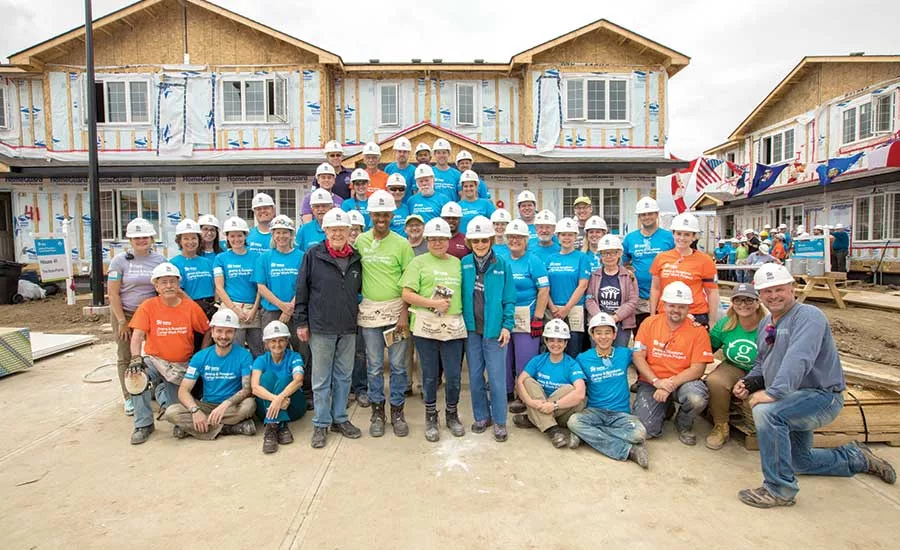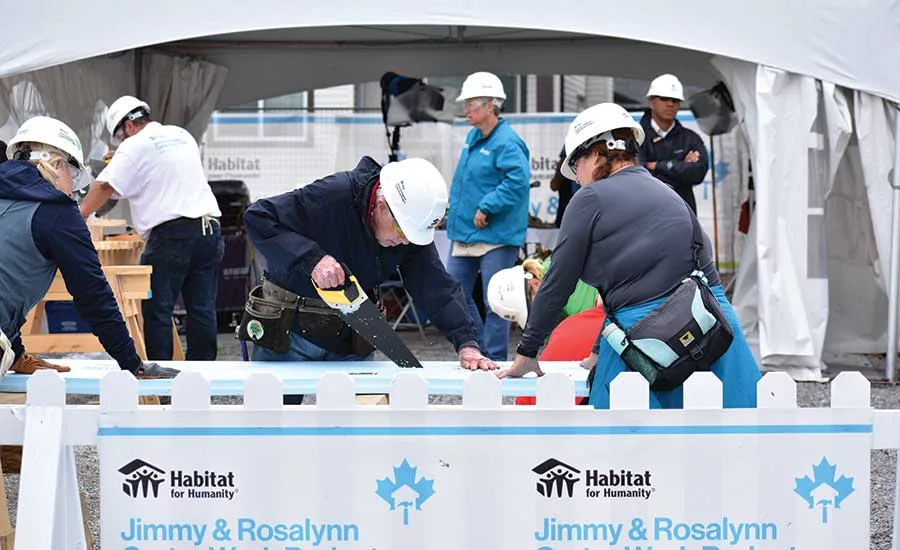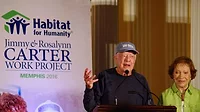Carter Work Project: A Canadian Collaboration
Habitat for Humanity's Jimmy & Rosalynn Carter Work Project Celebrates Canada's 150 Years with 150 Homes

Volunteers with the Jimmy & Rosalynn Carter Work Project — including RC Editorial Director Rick Damato (center, blue shirt) — gathered in Edmonton, Canada last July to help build affordable housing for families in need. The partnership with Habitat for Humanity built 150 homes in 2017 to commemorate Canada’s 150th anniversary of Confederation.

Former U.S. President Jimmy Carter (center) gets to work with other volunteers helping to build affordable homes as part of the 2017 Carter Work Project in Edmonton, Canada, last July. He and former first lady Rosalynn Carter established the annual campaign in 1984 and have since partnered with Habitat for Humanity to help people achieve affordable home ownership across the globe.

Former U.S. President Jimmy Carter gets to work with other volunteers helping to build affordable homes as part of the 2017 Carter Work Project in Edmonton, Canada, last July. He and former first lady Rosalynn Carter established the annual campaign in 1984 and have since partnered with Habitat for Humanity to help people achieve affordable home ownership across the globe.
Former U.S. President Jimmy Carter has had numerous accomplishments before and after spending four years as POTUS. On the way to the White House, he graduated in the top ten percent of his class from the U.S. Naval Academy, ran his family’s farm and business, and served in several local and state offices, including Governor of the state of Georgia. Along the way he married the former Rosalynn Smith and they raised four children together.
One Habitat for Humanity Family’s True Story
By Asfaw Amare and Ehite Gizaw
Becoming owners of a Habitat for Humanity home has been one of the greatest blessings our family has ever received. We immigrated to America with $500 in our pockets and hopes of the American dream in our hearts. Owning our own land and raising our family in a safe and loving home has always been... ( Read more )
Since then, President and Mrs. Carter have been working tirelessly as advocates for peace and justice in the world. The Carters have been living by the motto of The Carter Center, established after leaving the presidency, “Waging Peace. Fighting Disease. Building Hope.” The many accomplishments in his post-presidential work led to his recognition as a Nobel Laureate in 2002.
In the meantime, the Carters began working with Habitat for Humanity International, an ecumenical Christian housing ministry (see Fast Facts on page 60). One trip to New York City in 1984 to help in the rebuilding of an apartment building led to the annual Jimmy and Rosalynn Carter Work Project, which has since crisscrossed the globe. To date, President and Mrs. Carter have served with over 92,260 volunteers in 14 countries to build, renovate and repair 3,944 homes.
Roofing Contractor went along on the most recent Carter Project in Edmonton, Alberta, Canada. In celebration of Canada’s 150th Anniversary of Confederation, the Carter Project worked to build 150 homes in all ten provinces in Canada with the primary worksites in Edmonton and Winnipeg. It should be noted that Roofing Contractor’s parent company, BNP Media, supported the Carter Project as a sponsor.
Did You Know?
- Habitat for Humanity International (HFHI) is a non-profit, ecumenical Christian housing ministry founded in 1976 by Millard and Linda Fuller.
- It’s managed by an ecumenical, international board of directors.
- The organization seeks to eliminate sub-standard housing and homelessness, and make decent shelter a matter of conscience and action.
- It builds and rehabilitates houses through volunteer labor and donations of money and materials.
- HFHI provides a “hand up,” not a handout: partner families help build their own homes and pay for them with affordable mortgages.
- Families are selected based on level of need, willingness to participate and ability to repay the no-interest loan.
- Neither race nor religion is a factor in choosing partner families.
- HFHI is active in more than 70 countries and nearly 1,400 communities across the U.S.
- It’s currently assisting in the recovery and rebuilding from the 2017 hurricane season in the Gulf Coast states and Puerto Rico.
- The organization works with governments and agencies to fulfill its mission of eliminating poverty housing.
This Carter Project worked on a townhome community of 59 homes in the Laurel neighborhood of Edmonton. As with all homes constructed by Habitat, the homes were constructed according to local codes and to conform to local styles. Local developers are required to put aside a certain percentage of the land they develop for affordable housing, which cleared a major hurdle faced by many Habitat projects: the cost and availability of buildable land.
The homes were being constructed with full basements which were to be substantially finished. The building our team worked on had five units and we spent the week hanging gypsum wallboard and vinyl siding. Other teams worked on forming and pouring basement walls and foundations and framing.
Before beginning work for the week, and before each day, the Habitat Edmonton construction leaders presented robust safety instructions. The “safety first” attitude is part of the Habitat culture, and the rules for construction safety in Canada are promulgated and enforced by the Canadian Centre for Occupational Health and Safety (CCOHS). If this sounds familiar, it’s very much like our OSHA, but different. Some of their standards are much tougher (they are all over personal protective equipment standards and usage) and some are what you may consider more lenient. In most cases, the maximum height to work unprotected in construction in the U.S. is 6 feet but in Canada it is 3 meters, although the Edmonton Habitat policy is 8 feet.
In addition to the good instructions and vigilance on the worksite, all volunteers were instructed to bring and wear steel-toed shoes that bore the “Green Triangle” indicating they were approved by the Canadian Standards Association (CSA). This designation provides shoes that have not only steel-toes, but sole protection as well and are built for heavy work environments. Not cheap up front, but they certainly worked on this project.
The Jimmy and Rosalynn Carter Work Project is funded by government agencies, churches, civic organizations, and corporate sponsors. Volunteers came from all over the world, but primarily from Canada and most from the Edmonton area. Many were associates of the corporate sponsors. All Habitat homeowners must go through a rigorous process to be chosen as homeowners and must then put money and “sweat equity” in as down payments before closing. So, every unit under construction on the project had one or more family members working side-by-side with volunteers every day for the build week.
The Weldemichael family were the future owners of the unit we worked on, and husband and father of three, Teferi, worked hard every hour of every day. The Weldemichael family emigrated from Eritrea, which was formerly a part of Ethiopia in the northeastern part of Africa. He works as a custodian in a local high school and has a smile as wide as Canada itself. We had the opportunity to meet his wife, Ehite, and their three children at the end the work week. As an item of interest, you may read the story of another Ehite, who, with her family immigrated to the U.S. and became Habitat Homeowners in 2009 (see above).
Fast Facts
- The Jimmy and Rosalynn Carter Work Project started in 1984 when President and Mrs. Carter took a busload of friends from Georgia to New York City to rehab the Mascot Flats building.
- Of the 30 original residents of the renovated Mascot Flats over 30 years ago, 19 still call it home.
- It partners with local affiliates of Habitat for Humanity International throughout the United States and the world.
- The project raises awareness of the need for affordable housing, and actively demonstrates how the Habitat model works to build lives and communities.
- Carter Projects in the U.S. range from coast to coast, including Los Angeles, Atlanta, Baltimore, Washington D.C., Birmingham, and Memphis.
- Carter Projects also built and renovated homes in the Philippines, Hungary, Haiti, Vietnam, Thailand, China, and Mexico.
- To date, President and Mrs. Carter have served with over 92,000 volunteers to build, renovate, and repair 3,944 homes in 14 countries.
- Roofing Contractor has participated in and reported on the Carter Projects since 2000.
As for roofing on the Edmonton project, we missed that portion of the work. The logistics of roofing was too daunting with the site full of working volunteers. At least the way Edmonton Habitat does it. Despite the 8-foot rule, the construction leaders here have figured out a way to have volunteers build the roof framing and install the architectural shingles. The edge of the roofs were roughly 20 feet above grade, but the roof framing, decking, and shingling are all done on grade and then flown into place by crane. No working at height on these roofs.
And has been the case since 1984, President Carter, 93, and Mrs. Carter, 90, were on-site taking on construction tasks with the rest of the volunteers, which included other notables such as Edmonton Mayor Don Iveson and country-music superstars, Trisha Yearwood and Garth Brooks. Yearwood and Brooks have been Habitat for Humanity and Carter Project supporters since 2007.
The Carter Work Project in Canada has been successful, not only in the construction of the 150 homes, but in raising awareness of the need for affordable housing. While the economy in Canada is robust, high housing costs give rise to a shortage of affordable homes. In fact, 70 percent of the Project homeowners lived in unaffordable housing (30 percent or more of their gross income going toward housing costs), 47 percent lived in overcrowded housing (more than two people per bedroom), and 57 percent had moved three or more times during the past five years.
All of this leads to the benefits of homeownership. Having sufficient income (after housing costs) to pay for all the necessities of life while raising a family in a safe and stable home.
Spending time in Canada proved to be a wonderful experience all the way around. The people of Edmonton really are nice. “Nice” is how they describe themselves, and they’re serious about it. And the Poutine is awesome. If you don’t know what that is, you just need to hike it up to Canada and find out for yourself. Really, don’t Google it; just go.
Thankfully, the next time we travel to Edmonton, we’ll have some good friends to visit there.
Want to support the work of Habitat for Humanity in your city? Want to volunteer in your city or somewhere else in the world? Check out the online version of this article to get links for this and more information on all things Habitat, as well as the Carters and their continuing work at The Carter Center in Atlanta.
DONATE:
VOLUNTEER:
Looking for a reprint of this article?
From high-res PDFs to custom plaques, order your copy today!





